Birds in the News #35
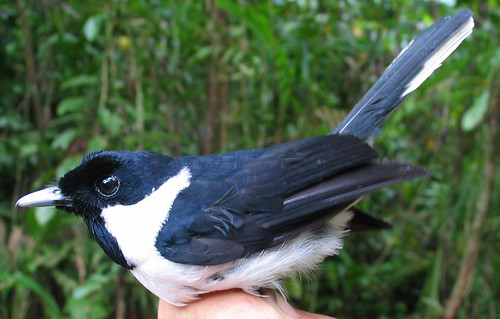
Pied Monarch, in hand.
Photo Credit: Christopher E. Filardi, American Museum of Natural History.
Birds in Science
Oceanic islands were always thought to be evolutionary dead ends, but new information show this is not always the case. Far from species hopping steadily down an island chain from a continent and coming to a dead stop, the research using new DNA techniques shows the process can actually go into reverse and spread back to the continents. "People have always assumed that the source for biodiversity has been continents," said lead author Christopher Filardi from the American Museum of Natural History, and a colleague of mine. The paper was published this week in the top-tier research journal, Nature. (One of the bird species featured in the study is pictured above).
The global decline in seabird populations is of growing concern to ecologists, and now researchers have discovered a new cause – some may be becoming too stupid to survive. Climate change may be the root of the trouble. New environmental conditions lead fish to migrate, leaving the birds
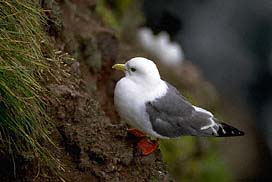 that feed on them malnourished. The new research shows that lack of a specific nutrient in red-legged kittiwakes, Rissa brevirostris (pictured), damages their cognitive abilities and could leave them too daft to find food. Red-legged kittiwake populations have plummeted by half since the 1980s in the Pribilof Islands in the southeastern Bering Sea. So another colleague of mine, Alexander Kitayski and colleagues at the Institute of Arctic Biology at the University of Alaska Fairbanks in Irving, US, devised an experiment to try to find out why. The sharp drop in the seabird numbers coincided with a climate shift that resulted in a reduced abundance of lipid-rich fish in the area, though other fish species remained available as food. The researchers theorised that chicks born at or after this time lacked the lipid-rich foods they needed for proper cognitive development, leaving them less likely to have the skills needed to survive as independent adults. “This is really fascinating research, and demonstrates a very complex mechanism driving a reduction in population,” says Mark Grantham, from the British Trust for Ornithology. “Climate change has had a noticeable effect on both the timing and success of breeding of many of our bird species, but this new study just shows how unpredictable such consequences can be.”
that feed on them malnourished. The new research shows that lack of a specific nutrient in red-legged kittiwakes, Rissa brevirostris (pictured), damages their cognitive abilities and could leave them too daft to find food. Red-legged kittiwake populations have plummeted by half since the 1980s in the Pribilof Islands in the southeastern Bering Sea. So another colleague of mine, Alexander Kitayski and colleagues at the Institute of Arctic Biology at the University of Alaska Fairbanks in Irving, US, devised an experiment to try to find out why. The sharp drop in the seabird numbers coincided with a climate shift that resulted in a reduced abundance of lipid-rich fish in the area, though other fish species remained available as food. The researchers theorised that chicks born at or after this time lacked the lipid-rich foods they needed for proper cognitive development, leaving them less likely to have the skills needed to survive as independent adults. “This is really fascinating research, and demonstrates a very complex mechanism driving a reduction in population,” says Mark Grantham, from the British Trust for Ornithology. “Climate change has had a noticeable effect on both the timing and success of breeding of many of our bird species, but this new study just shows how unpredictable such consequences can be.”People Helping Birds
Good News! New Jersey and Delaware officials finally came to their collective senses when they agreed this week to cut the harvest of horseshoe crabs in half, a move intended to stop the decline of both the helmet-shaped creatures as well as the migrant shorebirds that feed on their eggs.
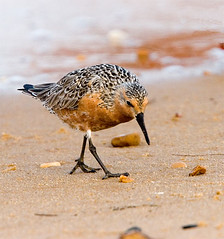 The agreement, which still must be ratified by fisheries councils in each state, also would prohibit harvesting during the horseshoe crabs' prime spawning season, May 1 through June 7. Public access to some Delaware Bay beaches also would be limited to reduce shorebird disturbance. Environmental groups welcomed the move as a step toward a total ban on horseshoe crab harvests. A decline in their spawning numbers has roused the concern of environmentalists and international researchers who believe migrating shorebirds, particularly the endangered red knot, Calidris canutus (pictured), a long-distance migrant who are not finding enough crab eggs to eat when they arrive on Delaware Bay beaches to refuel each spring. "The Delaware Bay is a shared resource and drastic measures are called for on both sides of the waterway to address the alarming decline of the horseshoe crab population and wildlife that depends on horseshoe crab eggs as a primary food source," Department of Environmental Protection Commissioner Bradley M. Campbell said. GrrlScientist says: I am keeping my fingers crossed that this was enacted in time to save the red knot, whose Delaware Bay numbers declined dramatically from more than 150,000 to approximately 17,000 in less than 10 years.
The agreement, which still must be ratified by fisheries councils in each state, also would prohibit harvesting during the horseshoe crabs' prime spawning season, May 1 through June 7. Public access to some Delaware Bay beaches also would be limited to reduce shorebird disturbance. Environmental groups welcomed the move as a step toward a total ban on horseshoe crab harvests. A decline in their spawning numbers has roused the concern of environmentalists and international researchers who believe migrating shorebirds, particularly the endangered red knot, Calidris canutus (pictured), a long-distance migrant who are not finding enough crab eggs to eat when they arrive on Delaware Bay beaches to refuel each spring. "The Delaware Bay is a shared resource and drastic measures are called for on both sides of the waterway to address the alarming decline of the horseshoe crab population and wildlife that depends on horseshoe crab eggs as a primary food source," Department of Environmental Protection Commissioner Bradley M. Campbell said. GrrlScientist says: I am keeping my fingers crossed that this was enacted in time to save the red knot, whose Delaware Bay numbers declined dramatically from more than 150,000 to approximately 17,000 in less than 10 years.Each year on November 7th, one of the world’s richest bird areas is celebrated. "November 7th is a reminder each year that the forests of the Tumbesian region represent one of the richest and most threatened sites for biodiversity on the planet," said Amiro Perez-Leroux, BirdLife Americas Partner Development Officer. The Tumbesian region, which stretches from northern coastal Ecuador south to just north of Lima in Peru, holds exceptional levels of endemic bird species – species found nowhere else on the planet. However, heavy deforestation has resulted in many of its inhabitants becoming threatened, converting the region into a major conservation priority for BirdLife and other conservation organisations.
BirdLife's new Global Office in Cambridge, UK, was officially opened recently by Her Imperial Highness Princess Hisako Takamado of Japan, BirdLife's Honorary President. After a lifetime of strong interest in birds combined with many years of activism on their behalf, HIH Princess Takamado was named to be BirdLife International's Honorary President in 2004.
 Buzzards are again breeding successfully across Scotland after years of decline, a leading conservation body has found. Research by RSPB Scotland indicated the birds of prey, dubbed miniature eagles, have again started to breed and live in some of Scotland's most densely populated and built-up areas. Until recently the birds were largely confined to the west of Scotland but have now become more evenly distributed throughout eastern farmland areas. In the past, many were shot and many also died due to ill effects of agricultural pesticides. Their spread and overall increase is also attributed to a reduction in poisoning and trapping, particularly in the lowlands.
Buzzards are again breeding successfully across Scotland after years of decline, a leading conservation body has found. Research by RSPB Scotland indicated the birds of prey, dubbed miniature eagles, have again started to breed and live in some of Scotland's most densely populated and built-up areas. Until recently the birds were largely confined to the west of Scotland but have now become more evenly distributed throughout eastern farmland areas. In the past, many were shot and many also died due to ill effects of agricultural pesticides. Their spread and overall increase is also attributed to a reduction in poisoning and trapping, particularly in the lowlands.People Hurting Birds
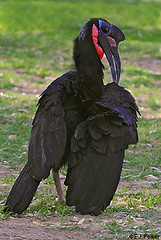
The stately Southern Ground Hornbill, Bucorvus leadbeateri (pictured at left), or "Lehututu" as it's locally called, may not be around for much longer. These huge black birds with their distinctive beaks and bright red wattles are part of the hornbill family that occur naturally only in Africa and Asia. But hornbill numbers are declining due to habitat destruction. "Many species will not survive without human intervention," said chief executive officer of the Limpopo Tourism and Parks Board, Benny Boshielo.
The flock of conures known as the Wild Parrots of Telegraph Hill, that took up residence on a hill overlooking the San Francisco bay, becoming the subject of a documentary and best-selling book, are searching for a new home after one of their perches was cut down and two others face a similar fate. Mark Bittner, who brought attention to the birds that have delighted tourists and residents for years, halted a crew this week before they cut down three cypresses whose owner wants them removed because they pose a hazard. "I would be a horrible human being if I wasn't helping my friends out, and they are my friends," Bittner, 53, said as he stood outside his cabin near the lone cypress stump and the surviving pair of trees.
Bird Flu News
Revealing once again that governments are often willfully stupid, the Vietnamese government recently issued a warning that kissing pet parrots can help spread bird flu. GrrlScientist rant: When will this dumbassery stop? Pet birds cannot spread avian influenza unless they have FIRST been exposed to birds that were already ill with the virus. This erroneous information is already causing problems for perfectly healthy companion parrots. And while I am ranting, I might as well add that I am appalled that wild birds are being blamed for spreading the bird flu across Asia when the evidence shows that this was not the case until very recently -- within the past few months. In fact, there is more evidence to suggest that during the five years previous to this, bird flu was spread by people who sell their sick poultry at market, and by people moving their cockfighting birds all over creation. By moving sick birds freely, and also by not keeping their sick domestic poultry separate from wild migratory birds, it appears that people infected wild birds with avian influenza, and now people are erroneously blaming wild birds as being the primary source of this virus. This allegation is ridiculous and is not reality based.
Are you afraid of catching bird flu from your bird feeder? Well, don't be. Naturalists say fears of an international bird flu pandemic should not stop anyone from enjoying birds at their backyard feeders. "Birds carry a variety of strains of avian flu," said David Bonter, of the Cornell Lab of Ornithology, during a telephone interview with The Tribune. "But most strains of flu don't affect birds (we would see) at feeders." GrrlScientist says; Base your bird feeding decisions on facts, not fears. Birders and bird feeders should continue to enjoy their activities. But use common sense. Cleanliness and sanitation should be maintained at all times, whether you’re a feeder or outdoor sportsman. And don't forget that the simplest behavior, hand-washing, will tremendously reduce your rate of infection with any disease organism, including influenza viruses.
Streaming Birds
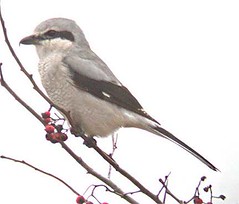 This week on BirdNote, we talk about the disappearance of scaup; mixed-species flocks; the Northern Shrike, Lanius excubitor (pictured); a bit about common sayings that have birds as subjects; and the episode I am most interested in, the relationship of birds to dinosaurs. BirdNote shows are two-minute vignettes that incorporate the rich sounds of birds provided by Cornell University and by other sound recordists, with photographs and written stories that illustrate the interesting -- and in some cases, truly amazing -- abilities of birds. Some of the shows are Pacific Northwest-oriented, but many are of general interest. BirdNote can be heard live, Monday through Friday, 8:58-9:00AM on the radio throughout Western Washington and Southwest British Columbia and is also available as RSS/Podcast feeds from BirdNote. Congratulations as BirdNote expands its listernership: this is the first week when BirdNote are broadcast on the radio in North Central Washington state (they also stream BirdNote live). All episodes are available in the BirdNote archives, both in written transcript and mp3 formats, along with photographs. [mp3/podcast].
This week on BirdNote, we talk about the disappearance of scaup; mixed-species flocks; the Northern Shrike, Lanius excubitor (pictured); a bit about common sayings that have birds as subjects; and the episode I am most interested in, the relationship of birds to dinosaurs. BirdNote shows are two-minute vignettes that incorporate the rich sounds of birds provided by Cornell University and by other sound recordists, with photographs and written stories that illustrate the interesting -- and in some cases, truly amazing -- abilities of birds. Some of the shows are Pacific Northwest-oriented, but many are of general interest. BirdNote can be heard live, Monday through Friday, 8:58-9:00AM on the radio throughout Western Washington and Southwest British Columbia and is also available as RSS/Podcast feeds from BirdNote. Congratulations as BirdNote expands its listernership: this is the first week when BirdNote are broadcast on the radio in North Central Washington state (they also stream BirdNote live). All episodes are available in the BirdNote archives, both in written transcript and mp3 formats, along with photographs. [mp3/podcast].Miscellaneous Birds
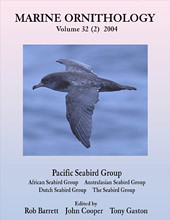
If you enjoy marine birds, then you will also be interested to read the research journal, Marine Ornithology, that is dedicated to them. This journal is also published online and provides free PDFs of all papers published in volumes 16 to the present.
How are your bird identification skills? You can test them by going to Bird Quizzes and find out. The tests are designed to challenge novice, intermediate and advanced birders and the answers to the quiz are posted to the website at the end of the month. This website also has a comments section (similar to what you find on blogs) that you might find interesting.
There is a new bird website out there, eBird, that focuses on birds in and around Ontario. Their most recent article, winter finch predictions discusses nine winter finch species and three erruptive passerines to expect in the Ontario area. The article features a beautiful picture of one of my favorite bird species, the Bohemian Waxwing, Bombycilla garrulus.
Thanks to my bird pals; Frank, Cheri, John, Dawn, Michael, Ellen and Ron for some of the links you are enjoying here. Special thanks to MJE for financial support for Birds in the News.
tags: Birds in the News, ornithology, birds, avian, newsletter
© 2004, 2005, 2006 by GrrlScientist











3 Peer Reviews:
The "Wild Parrots of Telegraph Hill" in San Francisco are CONURES, not monk parrots!!!.
GAH! Thanks for the correction. My brain was somewhere in the South Pacific Islands, not in San Francisco.
GrrlScientist
who cares what kind of parrots,,nice
article..!
Post a Comment
<< Home